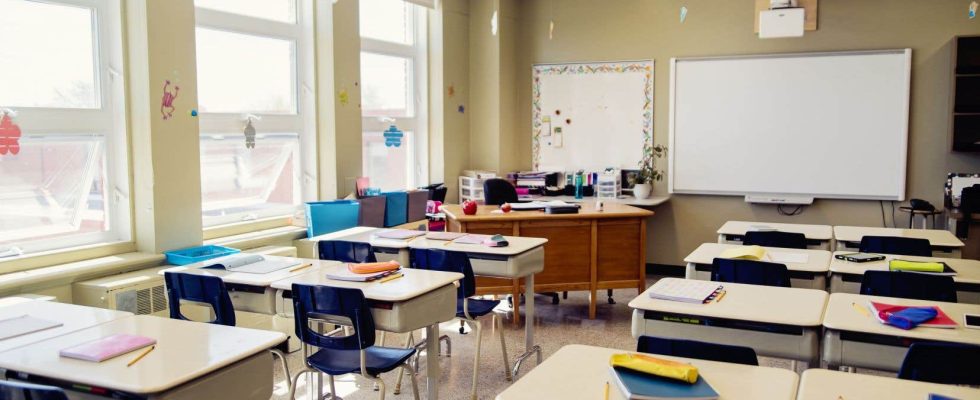The number of mechanically ventilated schools is stagnating in Quebec, and the oldest establishments in the province are over-represented among those where the ventilation of the premises depends entirely on the opening of windows, summer and winter.
A little more than 45% of some 2,740 public primary and secondary schools in Quebec are naturally ventilated, show data obtained by The duty under the Access to Information Act. In these establishments, it is up to teachers to closely monitor the evolution of the CO concentration.2 in their classroom and to regularly open the windows and the door to ensure adequate ventilation. This is particularly the case at Saint-Anselme elementary school in Montreal, where Annie-Sara Lemieux McClure teaches.
“In winter, I ask the children to bring an extra jacket to school because I often have to open the windows to ensure ventilation,” which leads to a drop in the temperature in the classroom, explains the teacher. . “When I open my windows, it’s very cold,” continues Mme Lemieux McClure. She would like her school to be equipped with a mechanical ventilation system, which would improve student comfort and reduce the “weight on the shoulders” of teachers.
However, the number of mechanically ventilated schools is stagnating in Quebec. In spring 2022, the results of a request for access to information conducted by The duty indicated that 45% of public schools in the province were ventilated only by opening windows. Data extracted in March by the Ministry of Education shows that this percentage has not changed since. Other schools in the province have a mechanical ventilation system in either part or all of their premises.
“The fact that the work does not seem to be progressing is worrying,” says the president of the Autonomous Education Federation, Mélanie Hubert, regarding the installation of mechanical ventilation systems in the province’s schools.
“It’s a concern. [sur laquelle] we would like the ministry to put more energy into it. We need to feel a sense of urgency,” adds M.me Hubert, who asks Quebec to “accelerate” work aimed at modernizing ventilation in schools in order to ensure “good air quality”. Last month, data published by the Quebec government showed a slight deterioration in air quality in schools.
Joined by The duty, the Quebec Ministry of Education indicates that it has invested $550.9 million since July 2020 to improve air quality in schools, to which is added $271.1 million for the current school year. “Moreover, if we take into consideration the total surface area of schools, it is estimated that more than 68% of it is mechanically ventilated,” argues the ministry.
A question of public health
In the context of the pandemic, the government has also provided all classes in the province with CO readers2, in addition to investing in the purchase of air exchangers for some of them. However, this is insufficient, believes the president of the Centrale des syndicats du Québec, Éric Gingras.
“That doesn’t solve everything, having CO detectors2. We have to be able, when there are colder winters, to do something other than open the windows,” underlines Mr. Gingras. According to him, significant investments are necessary to increase the number of schools equipped with a mechanical ventilation system, Quebec not being immune to a new health crisis which would bring the debate on school ventilation back to the foreground.
A concern shared by doctor Marie-Michelle Bellon, who is a member of the board of directors of the Canadian COVID Society. The organization campaigns in particular for better ventilation in schools, which is associated with a reduction in the spread of respiratory viruses.
“Infected students miss a lot of school, and this has an impact on their academic career,” underlines Mme Bellon, who also notes that the installation of CO readers2 cannot in itself be sufficient to improve the air quality of establishments. “The next step is to go further and propose solutions when we see that the figures [la concentration de CO2 dans les classes] are high,” says the doctor.
Thus, until a mechanical ventilation system is installed in problematic classes, they could be equipped with air purifiers, she suggests.
Worse in older schools
An analysis of the Duty also shows that schools which do not have mechanical ventilation are on average older than all establishments in the province. Eight of the ten oldest schools in Quebec are on this list. New schools are generally equipped with a mechanical ventilation system.
However, in “old” schools, ventilation only represents “part of the problems” facing students and teachers, underlines Annie-Sara Lemieux McClure. “We are told not to put bugs on the walls for asbestos, we have warping walls, mold and mice in abundance. »
In this context, the doctor specializing in health and environment at the National Institute of Public Health of Quebec Stéphane Perron notes the importance of completely renovating the province’s dilapidated schools, where poor ventilation often represents only one causes, among other things, problems that affect the air quality in these establishments. These problems include the presence of lead in paint and radon in the air, he says.
“It is a priority to identify dilapidated schools and those at risk of becoming so and to intervene there first,” underlines the expert, who insists on the fact that mechanical ventilation is not, in itself, a panacea. “I would be very worried if we put all the effort into ventilation without taking into account the dilapidation of the buildings. »
With Sarah Boumedda
